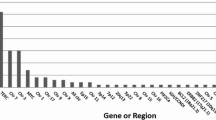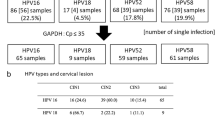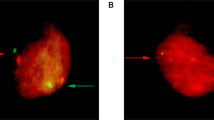Abstract
Most of cervical intraepithelial neoplasia 1 (CIN 1) will regress and 12% to 40% of high-grade CIN may progress to squamous cell carcinoma (SCC) of the uterine cervix. However, the differentiation of CIN 1 and high-grade CIN is sometimes controversial among pathologists. Human telomerase reverse transcriptase (hTERT) is therefore applied to detect the differences among normal, CIN 1, high-grade CIN, and SCC tissues of uterine cervix. One hundred six cervical specimens were collected for immunohistochemical study of hTERT. These data were compared with the human papillomavirus (HPV) DNA status. Expression of hTERT in high-grade CIN increased significantly compared to that in CIN 1 (P < .001). A positive relationship was found between high hTERT expression and degree of malignant transformation (P < .001). Most of the cases with high hTERT expression tested positive for the high-risk HPV groups. High hTERT expression was detected in 88.73% of the samples with cervical high-grade CIN or SCC. Low hTERT expression was found in 94.29% of low-grade CIN or normal tissues. Furthermore, 96.92% of the cervical tissues with high hTERT expression were high-grade CIN or SCC. A total of 80.49% of samples with low hTERT expression were low-grade CIN or normal tissues. A significantly increased hTERT expression between CIN 1 and high-grade CIN exhibits a critical progression in cervical carcinogenesis. hTERT can be offered as additional molecular information correlated with more severe dysplasia and SCC. Furthermore, this increased hTERT expression is correlated w high-risk HPVs infection.
Similar content being viewed by others
References
Saraiya UB. Preventable but not prevented: the reality of cervical cancer. J Obstet Gynaecol Res. 2003;29:351–359.
Richart RM, Barron BA. A follow-up of patients with cervical dysplasia. Am J Obstet Gynecol. 1969;5:386–393.
Hatch KD, Hacker NF. Intraepithelial disease of the cervix, vagina, and vulva. In: Berek JS, Adashi EY, Hillard PA, eds. Novak’s Gynecology. 12th ed. Baltimore, MD: Williams & Wilkins; 1996:447–448.
National Cancer Institute Workshop. The 1988 Bethesda system for reporting cervical/vaginal cytological diagnoses. JAMA. 1989;262:931–934.
Wright TC Jr, Richart RM. Pathogenesis and diagnosis of preinvasive lesions of the lower genital tract. In: Hoskins WJ, Perez CA, Young RC, eds. Principles and Practice of Gynecologic Oncology. 2nd ed. Philadelphia, PA: Lippincott-Raven; 1997:678–680.
Pinto AP, Crum CP. Natural history of cervical neoplasia: defining progression and its consequence. Clin Obstet Gynecol. 2000;45:352–362.
Mitchell MF, Tortolero-Luna G, Wright T, et al. Cervical human papillomavirus infection and intraepithelial neoplasia: a review. J Natl Cancer Inst Monogr. 1996;21:17–25.
Blackburn EH. Telomere states and cell fates. Nature. 2000; 408:53–56.
Greider CW. Telomerase activity, cell proliferation, and cancer. Proc Natl Acad Sci U S A. 1998;95:90–92.
Harley CB, Sherwood SW. Telomerase, checkpoints and cancer. Cancer Surv. 1997;29:263–284.
Shay JW, Bacchetti S. Telomerase activity in human cancer. Eur J Cancer. 1997;33:787–791.
Harle-Bachor C, Boukamp P. Telomerase activity in the regenerative basal layer of the epidermis in human skin and in immortal and carcinoma-derived skin keratinocytes. Proc Natl Acad Sci U S A. 1996;93:6476–6481.
Norrback KF, Roos G. Telomeres and telomerase activity in normal and malignant haematopoietic cells. Eur J Cancer. 1997;33:774–780.
Bodnar AG, Ouellette M, Frolkis M, et al. Extension of lifespan by introduction of telomerase into normal human cells. Science. 1998;279:349–352.
Counter CM, Meyerson M, Eaton EN, et al. Telomerase activity is restored in human cells by ectopic expression hTERT (hEST2), the catalytic subunit of temomerase. Oncogene. 1998;16:1217–1222.
Takakura M, Kyo S, Kanaya T, Tanaka M, Inoue M. Expression of human telomerase subunits and correlation with telomerase activity in cervical cancer. Cancer Res. 1998;58:1558–1561.
Beattie TL, Zhou W, Robinson MO, Harrington L. Reconstitution of human telomerase activity in vitro. Curr Biol. 1998;8: 177–180.
Weinrich SL, Pruzan R, Ma L, et al. Reconstitution of human telomerase with the template RNA component hTR and the catalytic protein subunit hTRT. Nat Gene. 1997;17:498–502.
Wisman GB, De Jong S, Meersma GJ, et al. Telomerase in (pre)neoplastic cervical disease. Hum Pathol. 2000;31: 1304–1312.
Liu K, Hodes RH, Weng Np. Cutting edge: telomerase activation in human T lymphocytes does not require increase in telomerase reverse transcriptase (hTERT) protein but is associated with hTERT phosphorylation and nuclear translocation. J Immunol. 2001;166:4826–4830.
Akiyama M, Hideshima T, Hayashi T, et al. Nuclear factor-κB p65 mediates tumor necrosis factor α-induced nuclear translocation of telomerase reverse transcriptase protein. Cancer Res. 2003;63:18–21.
Huang SL, Chao A, Hsueh S, et al. Comparison between the Hybrid Capture II Test and an SPF1/GP6+ PCR-based assay for detection of human papillomavirus DNA in cervical swab samples. J Clin Microbiol. 2006;44:1733–1739.
Huang HJ, Huang SL, Lin CY, et al. Human papillomavirus genotyping by a polymerase chain reaction—based genechip method in cervical carcinoma treated with neoadjuvant chemotherapy plus radical surgery. Int J Gynecol Cancer. 2004; 14:639–649.
Karlsen F, Kalantari M, Jenkins A, et al. Use of multiple PCR primer sets for optimal detection of human papillomavuirs. J Clin Microbiol. 1996;34:2095–2100.
Branca M, Giorgi C, Ciotti M, et al. Down-regulated nucleoside diphosphate (NDP) kinase nm23-H1 expression is unrelated to high-risk human papillomavirus (HPV) but associated with progression of CIN and unfavourable prognosis in cervical cancer. J Clin Pathol. 2006;59:1044–1051.
Frost M, Bobak JB, Gianani R, et al. Localization of telomerase hTERT protein and hTR in benign mucosa, dysplasia, and squamous cell carcinoma of the cervix. Am J Clin Pathol. 2000;114:726–734.
Yasumoto S, Kunimura C, Kikuchi K, et al.Telomerase activity in normal human epithelial cells. Oncogene. 1996;13:433–439.
Bravaccini S, Sanchini MA, Amadori A, et al. Potential of telomerase expression and activity in cervical specimens as a diagnostic tool. J Clin Pathol. 2005;58:911–914.
Zhang A, Wang J, Zheng B, et al. Telomere attrition predominantly occurs in precursor lesions during in vivo carcinogenic process of the uterine cervix. Oncogene. 2004;23:7441–7447.
Tsezou A, Oikonomou P, Kollia P, et al. The role of human telomerase catalytic subunit mRNA expression in cervical dyplasias. Exp Biol Med. 2005;230:263–270.
Wada H, Enomoto T, Yoshino K, et al. Immunohistochemical localization of telomerase hTERT protein and analysis of clonality in multifocal vulvar intraepithelial neoplasia. Am J Clin Pathol. 2000;114:371–379.
Engelhardt M, Albanell J, Drullinsky P, et al. Relative contribution of normal and neoplastic cells determines telomerase activity and telomere length in primary cancers of the prostate, colon and sarcoma. Clin Cancer Res. 1997;3:1849–1857.
Oikonomou P, Mademtzis I, Messinis I, Tsezou A. Quantitative determination of human telomerase reverse transcriptase messenger RNA expression in premalignant cervical lesions and correlation with human papillomavirus load. Hum Pathol. 2006;37:135–142.
Klingelhutz AJ, Foster SA, McDougall JK. Telomerase activation by the E6 gene product of human papillomavirus type 16. Nature. 1996;380:79–82.
Jeong Seo E, Jung Kim H, Jae Lee C, Tae Kang H, Seong Hwang E. The role of HPV oncoproteins and cellular factors in maintenance of hTERT expression in cervical carcinoma cells. Gynecol Oncol. 2004;94:40–47.
Oh ST, Kyo S, Laimins LA. Telomerase activation by human papillomavirus type E6 portein: induction of human telomerase reverse transcriptase expression through Myc and GCrich Sp1 binding sites. J Virol. 2001;75:5559–5566.
Veldman T, Liu X, Yuan H, Schlegel R. Human papillomavirus E6 and Myc proteins associate in vivo and bind to and cooperatively activate the telomerase reverse transcriptase promoter. Proc Natl Acad Sci U S A. 2003;100:8211–8216.
Park TW, Fujiwara H, Wright TC. Molecular biology of cervical cancer and its precursors. Cancer. 1995;76:1902–1913.
Ishiji T. Molecular mechanism of carcinogenesis by human papillomavirus-16. J Dermatol. 2000;27:73–86.
Author information
Authors and Affiliations
Corresponding author
Additional information
Grant support was provided by Chung Shan Medical University (funding no. CSMU 93-OM-B-025, CSMU 94-OM-B-030). Taiwan Molecular Diagnostic Laboratories Ltd offered the technical assistance for nested polymerase chain reaction-based genechip.
Rights and permissions
About this article
Cite this article
Wang, PH., Chen, GD., Chang, H. et al. High Expression of Human Telomerase Reverse Transcriptase in High-Grade Intraepithelial Neoplasia and Carcinoma of Uterine Cervix and Its Correlation With Human Papillomavirus Infection. Reprod. Sci. 14, 338–348 (2007). https://doi.org/10.1177/1933719107303986
Published:
Issue Date:
DOI: https://doi.org/10.1177/1933719107303986




